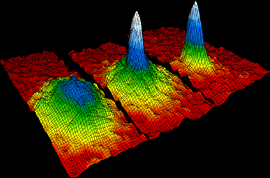
An international research team led by researchers from Skoltech and IBM has created an extremely energy efficient optical switch that could replace electronic transistors in a new generation of computers that operate with photons rather than electrons. The switch not only conserves power directly, it also does not require cooling, and is also very fast: capable of performing a trillion operations per second, it is 100 to 1000 times faster than the most efficient commercial transistors today. The results of the study, supported by the Russian Science Foundation, were published Wednesday in the scientific journal Nature.
“The new device is extremely energy efficient due to the fact that only a few photons are required to switch it,” commented the first author of the study, Anton Zasedatelev. “In fact, in Skoltech laboratories we have achieved switching even with one photon at room temperature,” added Professor Pavlos Lagudakis, head of the Hybrid Photonics Laboratory at Skoltech. “Nevertheless, there is a long way to go from observing the effect in the laboratory to developing real all-optical coprocessors.”
Since a photon is the smallest particle of light that exists in nature, scientists, in fact, have approached the limit of energy efficiency. If we talk about electrical transistors, then most of them today require tens of times more energy to switch, and those that achieve comparable efficiency – due to the manipulation of single electrons – work much slower.
Competing energy-efficient electronic transistors not only lose performance, but also require bulky cooling equipment, which in turn consumes additional energy and increases operating costs. The new switch can operate at room temperature and is therefore not affected by these problems.
In addition to its main function, the switch can act as a linking component that transfers data between them in the form of optical signals. It can also serve as an amplifier, increasing the intensity of the input signal up to 23,000 times.
How it works
The device uses two lasers to set its state to “0” or “1” and toggle between them. Conceptually, this works in such a way that a very weak reference laser beam is used to turn on or off another, brighter laser beam. For this, only a few photons are required in the reference beam, which is the reason for the high efficiency of the device.
But the difficulty lies in the fact that lasers by themselves are not able to influence each other due to the negligible weak interaction of photons. In order to implement the switching concept, you need some kind of environment. In our case, switching occurs inside a microcavity – an organic semiconducting polymer 35 nanometers thick sandwiched between highly reflective inorganic structures. The microcavity is designed in such a way as to keep the incoming light inside for as long as possible and enhance its interaction with the substance (organic polymer).
It is the strong interaction of light with matter that ensures the functioning of the new device. When inside the resonator photons interact with bound electron-hole pairs (excitons), exciton-polaritons arise – hybrid states of light and matter with a very short lifetime, which are so-called quasiparticles and underlie the operation of the switch.
When a pump laser – the brighter of the two – shines on the switch, thousands of identical quasiparticles are created in the same place, forming the so-called Bose-Einstein condensate, which encodes the logical states “0” and “1” of the device.
To switch between the two levels of the device, the team used a control laser pulse to create conditions for condensation to form shortly before the pump laser pulse appeared. Thus, the test pulse increases the efficiency of energy conversion of the pump laser, which in turn leads to a larger number of quasiparticles in the condensate. More particles correspond to the logical level “1” of the device.
Scientists have used a number of tricks to reduce energy consumption. First, vibrations of the semiconducting polymer molecules contributed to efficient switching. The trick is to match the energy of the pumping particles and the energy of the particles in the condensate using molecular vibrations in the polymer inside the resonator. Secondly, the team managed to find the optimal laser wavelength and implement a new measurement scheme that allows recording the state of the condensate in each individual implementation. Third, the condensate-forming reference laser and detection circuitry have been matched to minimize background noise from the device. These measures maximized the signal-to-noise ratio of the device and prevented the absorption of excess energy in the microcavity, thereby avoiding excessive heating of the device.
“We have work to do to reduce the overall power consumption of the device, which is currently dominated by a pump laser that keeps the switch active. One of the promising ways to achieve this goal may be perovskite supercrystalline materials, such as those that we are studying with colleagues. They are excellent for this purpose, because they provide a strong interaction of light with matter and, as a result, a powerful collective quantum response in the form of superradiance, ”- said the researchers.
The authors of the study emphasize the importance of the proposed principle of optical single-photon switching: it can be extended to other all-optical components that the team has been developing over the past few years. The suite includes, among other things, various logic gates, a cascade amplifier, and a low-loss silicon waveguide for transferring optical signals between transistors. The development of such components is systematically bringing us closer to the appearance of optical computers that will manipulate photons, not electrons, and due to this, work faster than traditional computers and consume less energy.
Read also:
Scientists have found a gene “fuse” for breast cancer metastases
Russian chemists have discovered new compounds of rare earth elements
Scientific communism of a healthy person
Furry conqueror: ash aphids have occupied all of Europe in 18 years
Scientists have described the possible cause of the green glow in the sky

